The Samsung 850 EVO 4TB SSD Review
by Billy Tallis on July 11, 2016 10:00 AM ESTMixed Random Read/Write Performance
The mixed random I/O benchmark starts with a pure read test and gradually increases the proportion of writes, finishing with pure writes. The queue depth is 3 for the entire test and each subtest lasts for 3 minutes, for a total test duration of 18 minutes. As with the pure random write test, this test is restricted to a 16GB span of the drive, which is empty save for the 16GB test file.
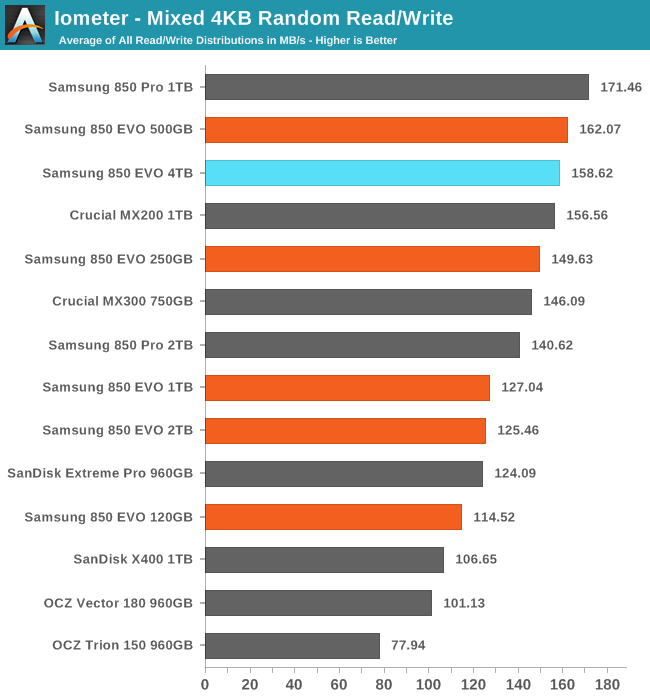
The mixed random I/O performance of the 4TB 850 EVO is much better than the other large 850 EVOs, putting te 4TB model close to the top of the chart.
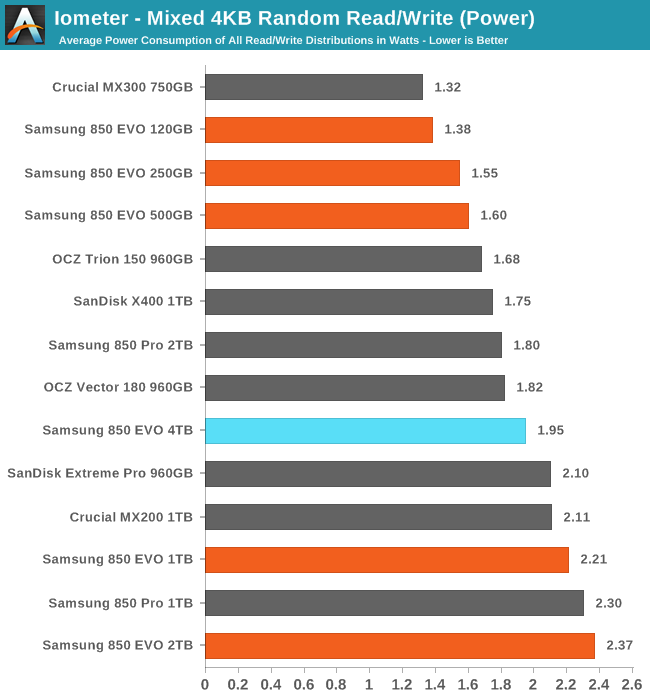
The 4TB 850 EVO also manages a large reduction in power usage as compared with the 1TB and 2TB 850 EVOs, making the 4TB much more efficient.
 |
|||||||||
Unlike the other 850 EVOs, the 4TB never loses performance as the proportion of writes in the test workload increases. Meanwhile, the power draw is essentially constant until near the end of the test.
Mixed Sequential Read/Write Performance
The mixed sequential access test covers the entire span of the drive and uses a queue depth of one. It starts with a pure read test and gradually increases the proportion of writes, finishing with pure writes. Each subtest lasts for 3 minutes, for a total test duration of 18 minutes. The drive is filled before the test starts.
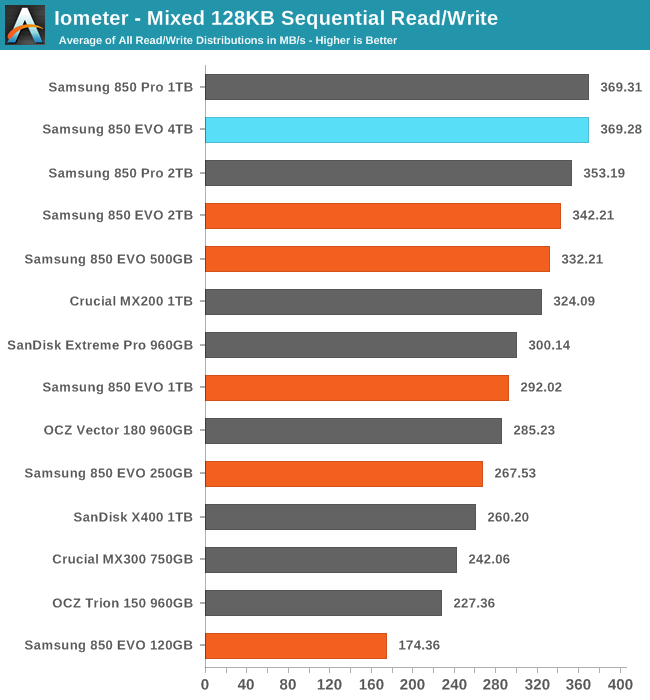
The 4TB 850 EVO is essentially tied for the best mixed sequential read and write performance.
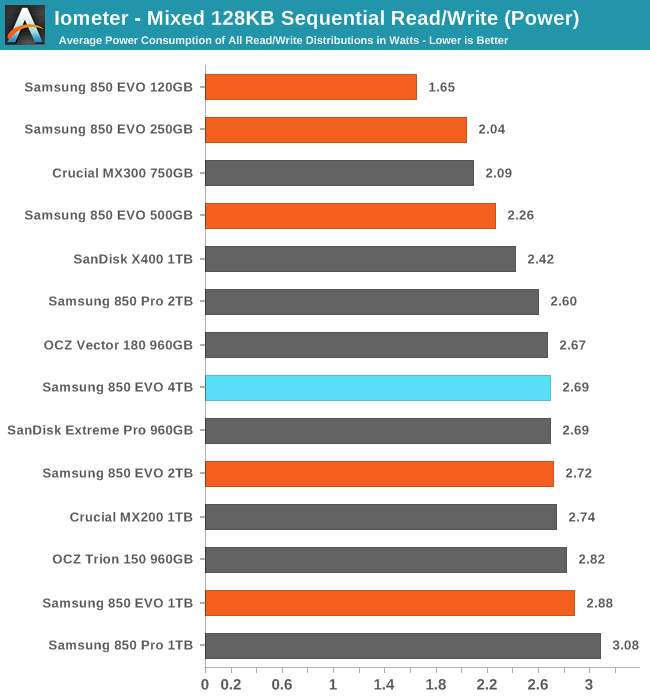
The 4TB 850 EVO averages using slightly less power than the 2TB model, and it is one of the most efficient of the large drives.
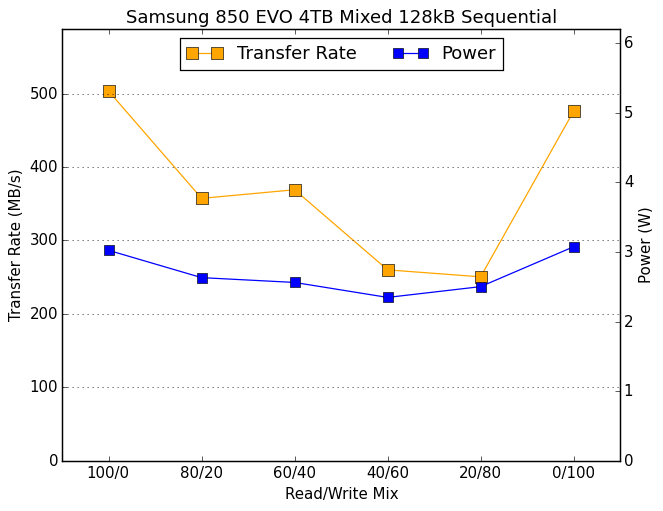 |
|||||||||
The usual pattern is for performance on this test to resemble a bathtub curve, but the 2TB 850s and the 4TB 850 EVO don't lose as much of their performance during the first half of the test, leading them to bottom out much later than most other drives.










145 Comments
View All Comments
Eden-K121D - Monday, July 11, 2016 - link
Too Expensive. $999 would have been a sweet spot and a potential option for meZak - Monday, July 11, 2016 - link
The price will come down. Eventually.Ratman6161 - Monday, July 11, 2016 - link
Doesn't really mater if the price goes down, its still a niche product. The EVO's are great general purpose desktop drives. But the people who need a general purpose desktop drive, mostly don't need 4TB and would not buy one at $500 let alone at $1500. In my case, I've got a 250GB Evo and a 1 TB spinning disk for storage of music, pictures, video etc. So I guess a cheap enough 2 TB SSD could work for me just because it would be marginally easier to not have two separate chunks of storage to deal with...but thats just a marginal increase in convienience. The stuff I have on a spinning disk doesn't really need the performance of an SSD anyway.I know, now someone will jump in with "well I sure need that 4 TB" but I still say that isn't the norm. I really don't believe they will sell very many of these compared to the 1 TB and below even if the price comes down.
Meteor2 - Monday, July 11, 2016 - link
I don't need it. But it's exciting to see this progress in SSDs. It'll take a while but mass production will bring the price/size ratio down.Impulses - Monday, July 11, 2016 - link
OTOH lack of competition will probably counter that to an extent... But I'm glad it exists too, if nothing else it might mean more sales on the 2TB. :pleexgx - Sunday, August 7, 2016 - link
was so funny when i clicked on 25% OP, but really the extra OP is really only needed for places where your writing constantly as normally the drive is Trimmed (most SSD/HDDs life is read then write, unless in a server setup that does lots of writes) the drives normal hidden OP is what 400-500MB ?beginner99 - Tuesday, July 12, 2016 - link
Agree. This shows that HDDs are here to stay for another decade. The same for 4 TB in form of a HDD can be had for about $130. So that 1/10th of the SSD price and as you said for media files, you don't need an SSD at all.Impulses - Wednesday, July 13, 2016 - link
Another decade? That seems like a stretch unless you're hoarding BD tips and the like... A decade ago we didn't even have SSDs.joex4444 - Tuesday, July 19, 2016 - link
If you have 4TB of stuff to store and it's mostly media that is accessed infrequently, it would only make sense to buy a 4TB SSD over a 4TB HDD if the prices are comparable. We've technically had SSDs for decades, it's just that they used to be in the millions of dollars per drive rather than $100 or so. Exactly how production will change to make 4TB drives cheaper isn't clear. It could be that we've already reached the lowest price per GB and all that remains is to have that scale linearly. This would mean that if 250GB drives cost $60, then a 4TB drive should cost 16 times that, or $960. Maybe some kind of discount could bring it into the $750 range, but in order to get down to $130 we need significant changes. That would put a 250GB drive on the order of $25.JimmiG - Wednesday, July 13, 2016 - link
Of course it's not "needed" right now, but it's nice to see progress. The 6 GB HDD I used in my Pentium system was plenty at the time - I didn't "need" those fancy new 20 GB drives...